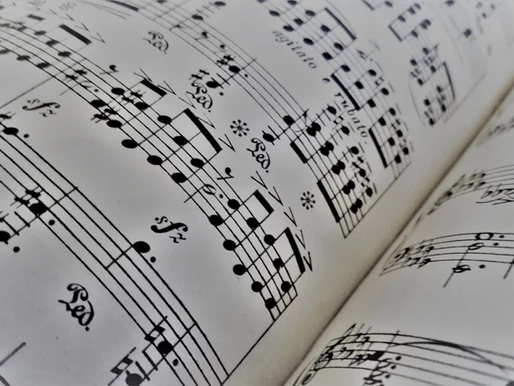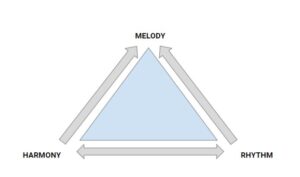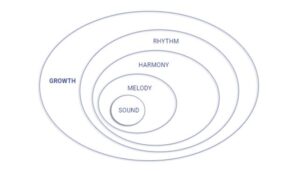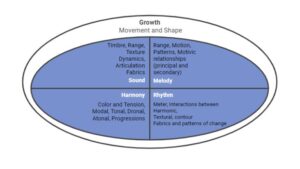Music Theory Resoucers, Piano Lessons
The five contributing elements in Music Analysis: Melody, Harmony, Rhythm, Sound, and Growth
Elements of the Music – Musical Analysis – Musical Elements
The music has seven essential elements that are the sound, the rhythm, the melody, the harmony, the growth, the texture and although the timbre is a quality of sound, it is effective to add it withing this group. These elements vary greatly according to the culture and time of a given music.
The timbre is the color of music, it is the quality of sound that makes us distinguish one voice from another, the different musical instrument, as well as the extra-musical sounds that the human ear can distinguish.
The timbre in music has been developed and has been a test subject, since composers and instrument builders throughout history have created different timbre options in search of innovation. Examples such as the different instrumental formats such as string orchestras, string quartets, wind quintets, classical orchestras, the romantic orchestra and with the arrival of 20th century experimentation reaches its peak, with the invention of electroacoustic music.
DEFINITIONS
Before we start the classification of each element, some definitions will clarify the concepts we will address in this article:
- MUSIC is composed of Rhythm, Harmony and Melody
- RHYTHM: ‘rhein’ meaning ‘to flow’ -”ρυθμός” repetitions of flow.”
- HARMONY: Means “agreement, concordance”; its root, “harmós”, means to join, assemble, connect in Greek.
- MELODY: It comes from the Greek “Melos”, which means “parts, units”.
- The Melody conveys a sense of that harmonic unity throughout the rhythm. To “Melos” was added the Indo-European word “aw” (to speak, to say), which derived from the Greek “aeidía”, meaning: to sing. The meaning is to speak with parts of the body, to sound in units.
We can see in the chart below the fundamental relationship between what we call “Music”, from which the most recognisable pattern, the Melody (that will be discussed later), is based on: Harmony and Rhythm and becomes the resulting element:
- Rhythm is the constant flow in which patterns of vibration and frequency are repeated (space and time, respectively), in which each of these repetitions is combined with each other, articulating in coherence and order, combined with Harmony, so that both elements obtain a logical meaning that can be transmitted inherently through the Melody.
- While Harmony and Rhythm are an objective and structural part of music, they are the least perceived by the conscious listener, but they are the key for the brain to “like” the piece.
- We can only enjoy the melody as long as the brain feels comfortable with both elements, harmony and rhythm, in coherence.
WHAT ARE THE FIVE ELEMENTS OF MUSIC?
Music Analysis is one of the most important tools for any composer. Even though we do something that could be considered unnatural, as we create an artificial situation when all the parts that in music are in constant motion, now they appear, let’s say, “frozen” to be studied moment by moment by themselves, this method allows us to see how exactly each one of the musical elements contributes to the resulting piece, or better said, how all the moving parts of musical composition are combined to work as a clock would do.
Musical composition is nothing but an intricate architectural combination of five parameters or musical elements: Sound, Rhythm, Melody, Harmony, and Growth. These parameters or musical features are unique among all branches of the arts, as their combination can mean an infinity of connotations either in the composer, the performer or the listener. These categories were coined by the great theorist Jan La Rue in his book “Guidelines for Style Analysis” and although it is not a book about the composition itself, it serves any composition student who wants to understand the intricacies of the musical phenomena on a deeper level.
1.- SOUND
In Musical Analysis, the sound is the first category that falls into the most basic and foundational one.
This contributing element includes not only the most obvious one: the raw material for melody, harmony, and rhythm, but should be considered as a “Sound Group”. This can be classified into three headings:
a – Timbre: either vocal, instrumental and any other combinations chosen by the composer
b – Dynamics: The intensity of the sound
c – Texture and Fabric: how the timbres are arranged and how they unfold throughout the piece
Timbre refers to the quality of the musical tone, and how the composers combine them. This can be expressed in the choice of timbres (woodwinds, percussion, strings, electronically generated sounds, etc) the range (total spectrum of the frequencies used in a piece or set of pieces, tessituras, which are voice ranges or perhaps the interest in exploiting extreme range possibilities) the degree and frequency of contrast ( the amount of timbral contrast used by a composer and how fast or slow are these changes). Finally, the idiom (the exploitation of the capacities of the instruments explored by the composer).
2.- HARMONY
Harmony is the gaze and the vertical conception of music. The superimposition of more than one voice sounding at the same time creates the so-called harmony. In practice, this broad definition can also include some instances of notes sounded one after the other. Harmony is primarily a vertical phenomenon. It also has a horizontal aspect, however, since the composer not only creates a harmonic sound at any given moment but also joins these sounds in a succession of harmonies that gives the music its distinctive personality.
Its contribution to the overall shape of the music can be classified in at least five important harmonic phenomena that can either cause or strengthen an articulation: change of mode, change of key, acceleration or deceleration in chord rhythm, intensification (or densification) of vertical complexity, and increase or decrease in frequency of dissonance. These changes in harmonic “pressure” affect the listener particularly strongly.
3.- MELODY
Melody refers to the profile formed by any collection of pitches. This is the most recognizable of the contributing elements as the first and easiest to grasp. But even the apparent most “simple” melody cannot be taken for granted, there is nothing simple about even, the smallest melodic actions, since no interval can be regarded as an absolute value, but must be weighted according to its durations, accentual circumstances, position in the range, location in the phrase, relationship to critical notes such as dominants and finals cadences, and function in the contour or pattern as peak, low, turning point, pivot, and so on.
The melody is composed of height and rhythm. In an extra-musical sense, it is itself composed of tonal colors. It is the foreground to the background accompaniment. A line or part need not be a foreground melody. The melody is organized by different elements such as phrases, (a group of notes that make sense together and express a definite melodic “idea”, but it takes more than one phrase to make a complete melody) and motifs, (a short musical idea – shorter than a phrase – that occurs often in a piece of music).
4.- RHYTHM
We can argue that rhythm encompasses many elements; we can relate it to the harmonic rhythm, to the melodic rhythm, the rhythm of the sound, texture and fabric itself as its parameter relates to the duration of different layers in the musical phenomenon, that is why we could consider it under an arch of ambiguity. By recognizing two axiomatic conditions, we will find some light into the matter:
-The rhythm is a layered phenomenon: To a large extent, rhythm results from changes in Sound, Harmony and Melody, in this respect relating closely to the fifth contributing element, the Growth, which will take on board on the last point of this article. This last element accomplishes an expansion of Rhythm on a large scale, just Rhythm controls the details of every small scale in the previous elements. Rhythm contains a larger proportion of specifically durational rhythmic effects such as patterns of surface rhythm (basically, the note values) while the movement of the harmony and sound contains more of the generalized resultants, such as contour rhythm and textural rhythm.
-Stress is variable in duration: Release of tension in not necessarily instantaneous, and as a result, durations of stress will ten to reflect the dimension affected: a motivic accent in Vivaldi may highlight only a single semiquaver, whereas in Beethoven may prolong a phrase stress for several beats by successive injections of his musical adrenalin like his most-known sforzando articulations.
These differing qualities and quantities within Rhythm deeply influence the processes of Growth.
The layers of Rhythm: We can’t define rhythm comprehensibly without mentioning its layers: Continuum, Tempo, Surface rhythm, and interaction.
The Continuum is the consciousness of a continuing pulse from which we infer a multidimensional structure of motion that carries through sustained notes or intervals of silence.
The tempo is the speed of operation of the continuum, typically governed by the speed of the controlling pulse or “beat”.
The Surface Rhythm includes all relationships of durations, assumed to be approximately as represented by the symbols of notation (note values)
Finally, the Interactions that result when the events in other elements approach a condition of regularity that can be felt either as reinforcement of the continuum or as patterning related to surface rhythms. The importance of these interactions is that they can give stress and directional movement to rhythmically undifferentiated situations, for example, the rhythmic flow produced by alternations of tutti and solo in concertos, or striking exchanges in fabric produce intermittent stresses without changing a single pitch.
5.- GROWTH
The word “growth” delineates and contains beautifully the intricacies of the multi-layered phenomenon of a musical piece, as it includes both the feeling of expansive continuation so characteristic of music and also a parallel sense of achievement something permanent. These two aspects are decisively interactive and can be separated into two parallel functions: Movement and Shape.
Musical Shape is the memory of the Movement, and only by the accumulation of degrees of punctuation and articulation, we can recognize the growing Shape.
We can observe the concept of the five contributing elements of music through the graphic below, in which we can perceive how the elements are contained and related to each other:
Another way to see the concept of Growth, and how it relates to and comprises the other contributing elements is through the graphic below, in which we can appreciate the different layers of each element working together with Growth as the combining and controlling parameter:
The Growth also can be seen as a Torus field, in which it is the generator from which all the elements (Sound, Melody, Harmony and Rhythm) emerge from it, but at the same time, adjusts the matrix of this controlling element, allowing a dual existence as a controlling agent, absorbing the contribution of the other elements and simultaneously adjusting the matrix of the patterns that they delineate, creating the musical phenomena.
You can see the phenomena here.
https://www.laetusinpraesens.org/docs10s/helixtor.php
CONCLUSION – Elements of Music
Music is essentially movement in every aspect of the word, even a single sound impacts the air and makes it move. Every sound followed by another creates a melodic outline that defines a piece, having an abstract meaning to the listener.
Every one of the 5 basic elements of the music mentioned in this article contributes to the overall Movement and Shape. And each and every one of them is crucial when we are doing musical analysis of songs or pieces.
Subdividing the contributing elements to a piece aids the musical phenomenon in five manageable parts. Otherwise, the amount of information would be impossible to dissect properly to understand the complexity of the interactions of the different layers in a musical piece.
If you would love to keep on learning, join our music analysis courses in London and online now. More info here.
#musicalanalysis #analysismusic




